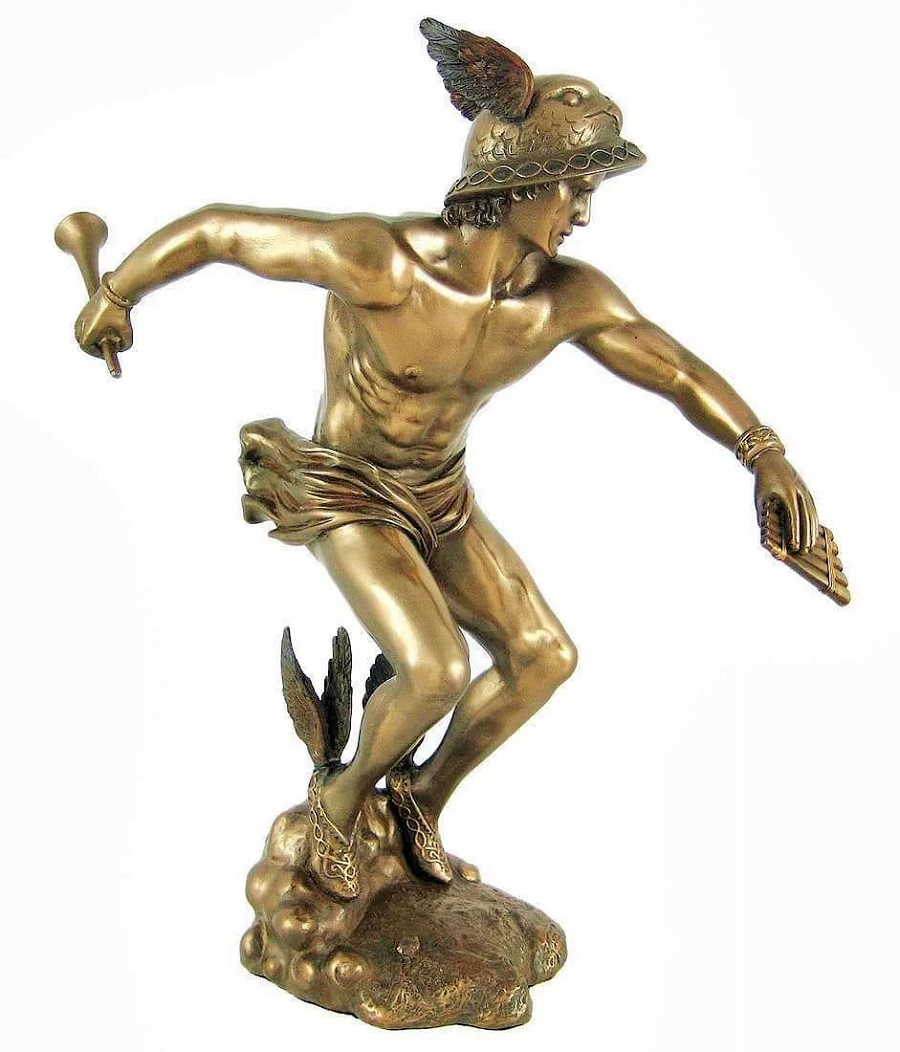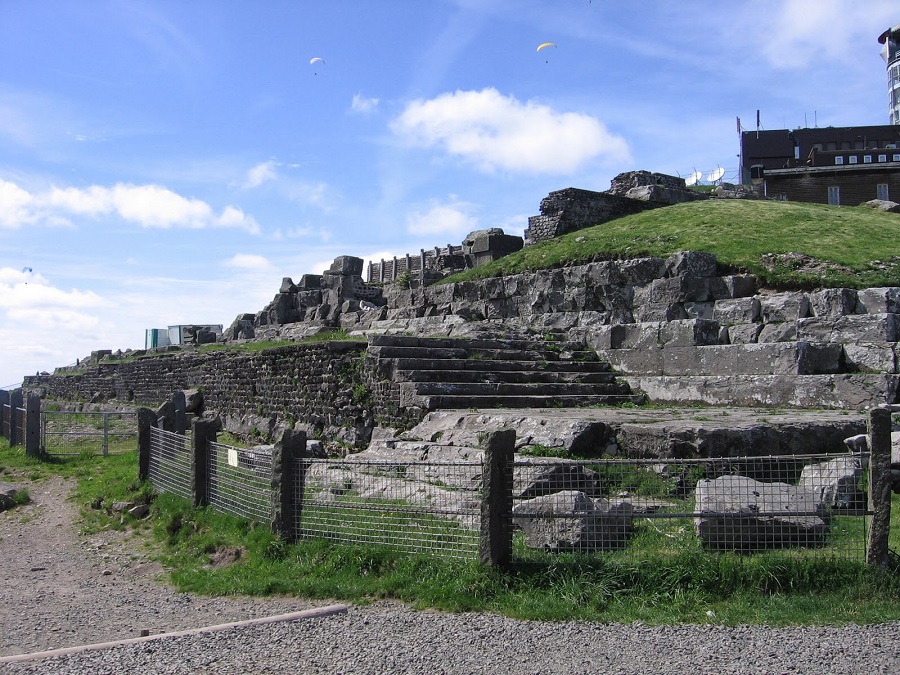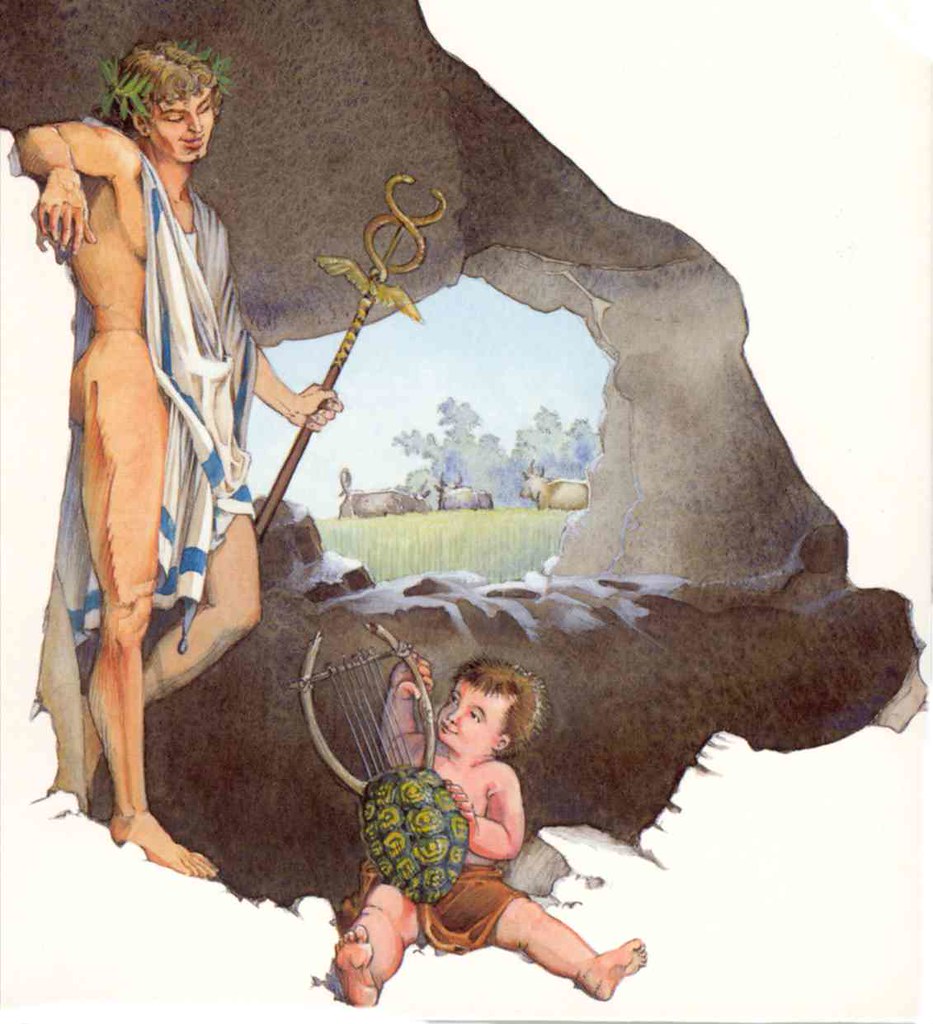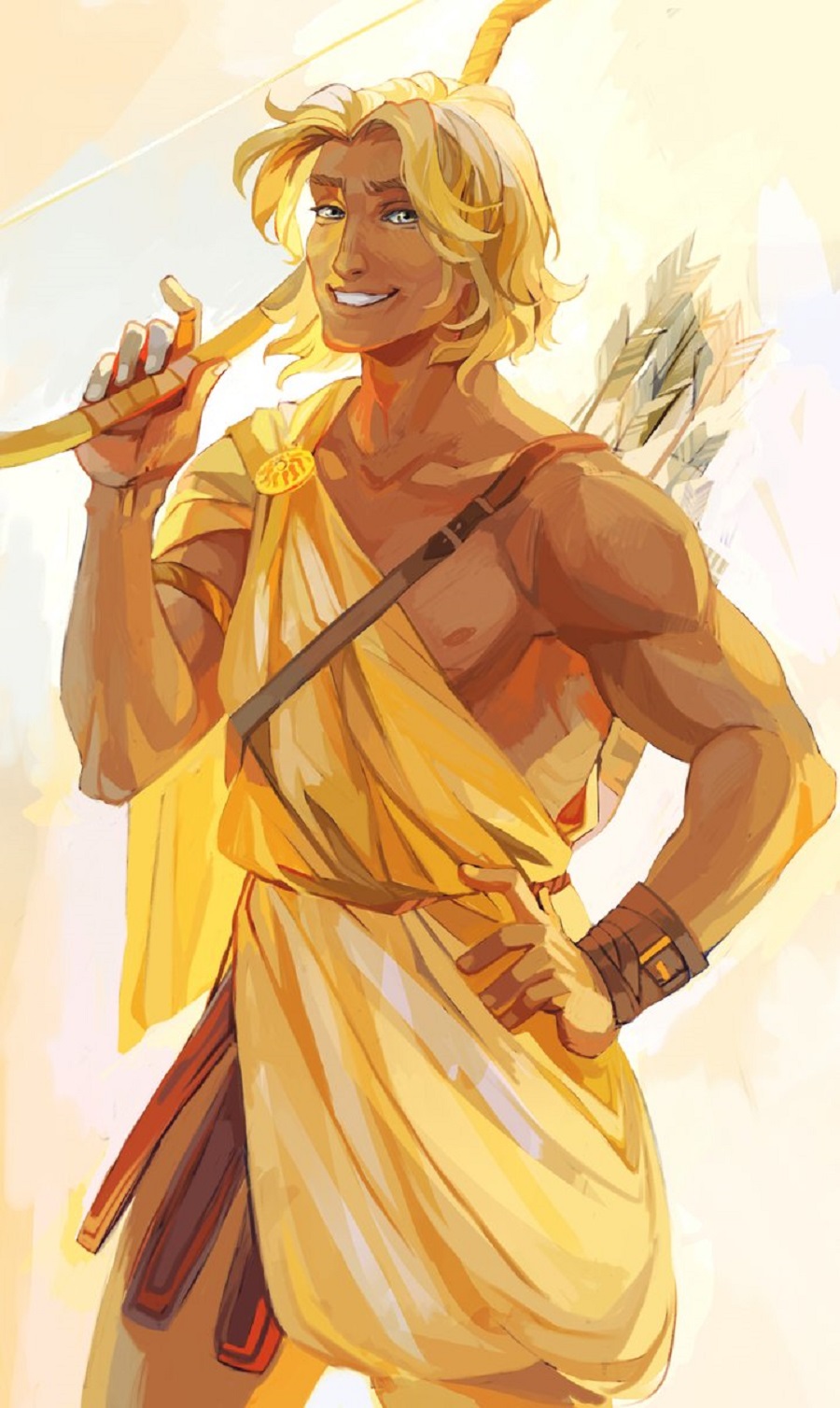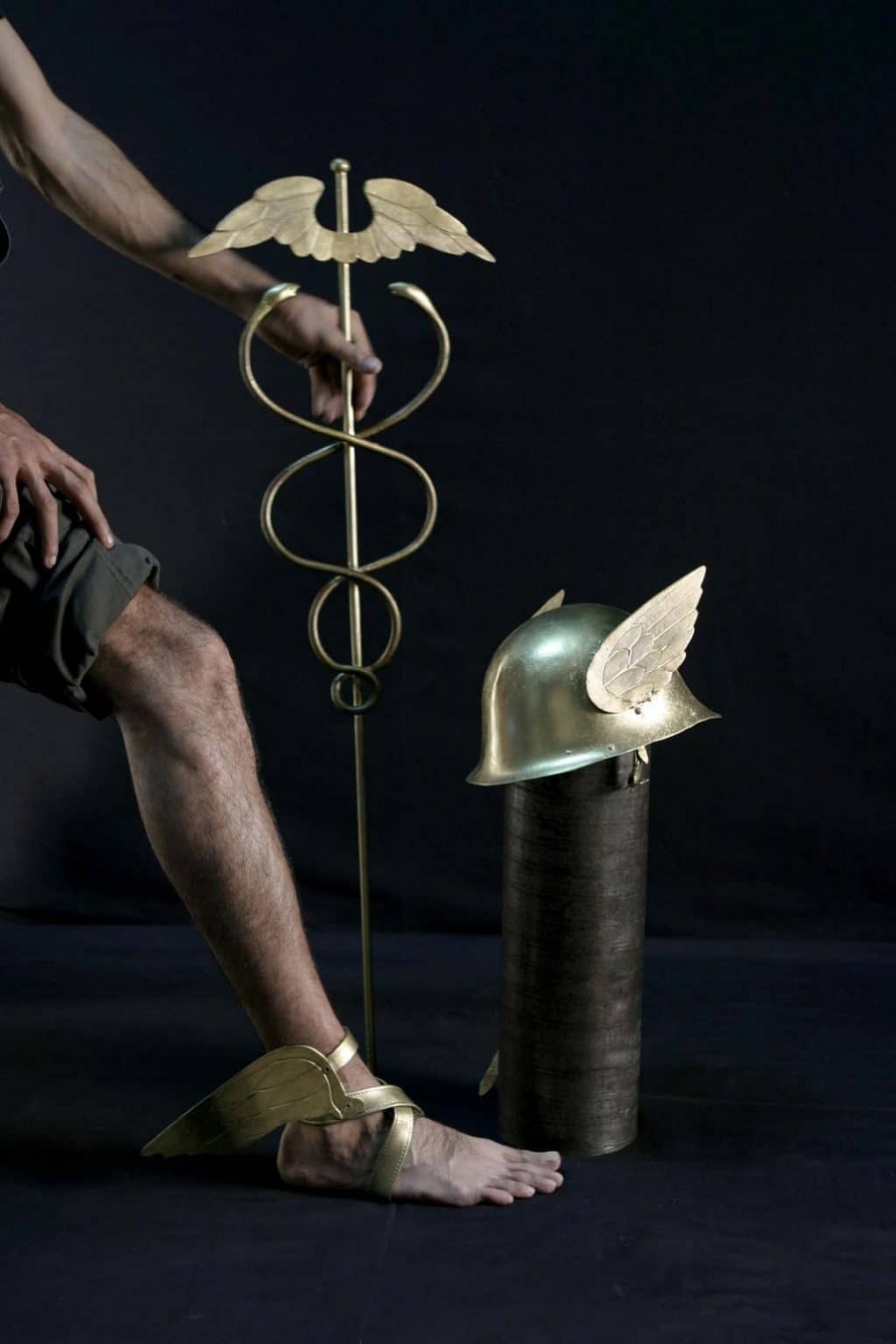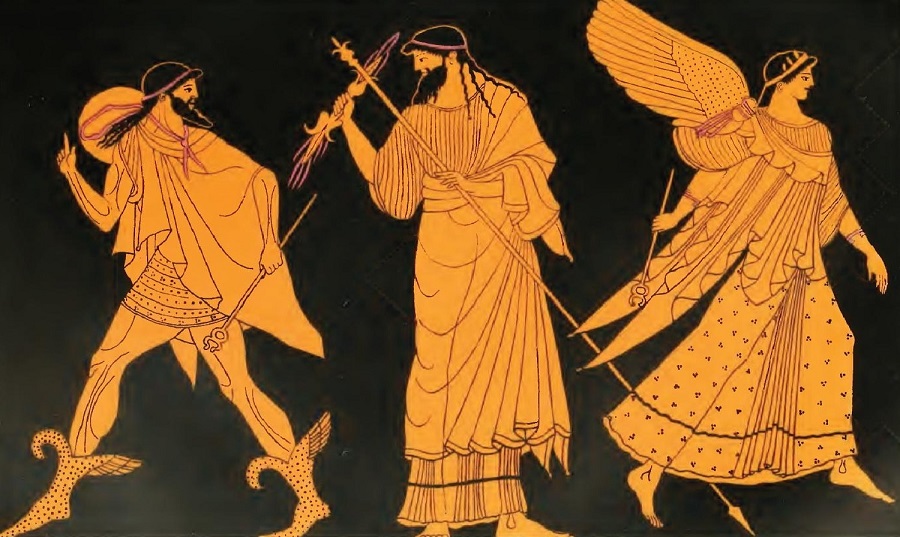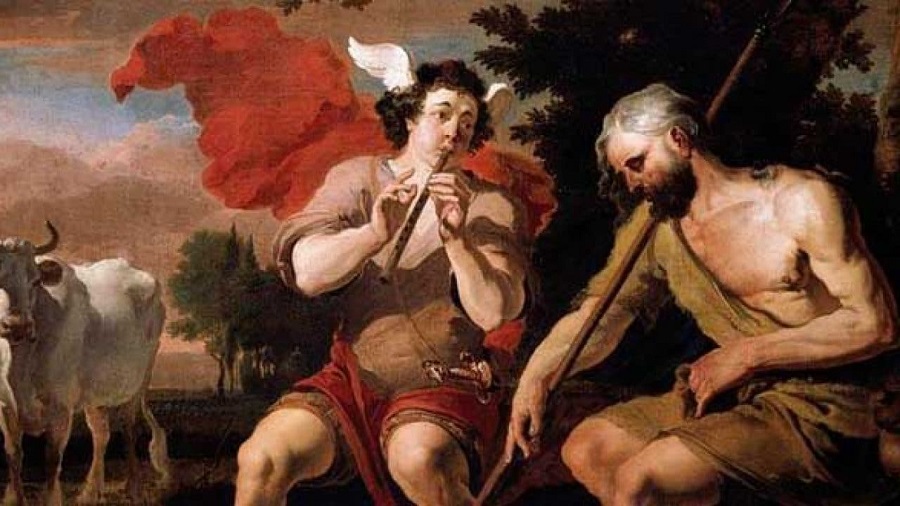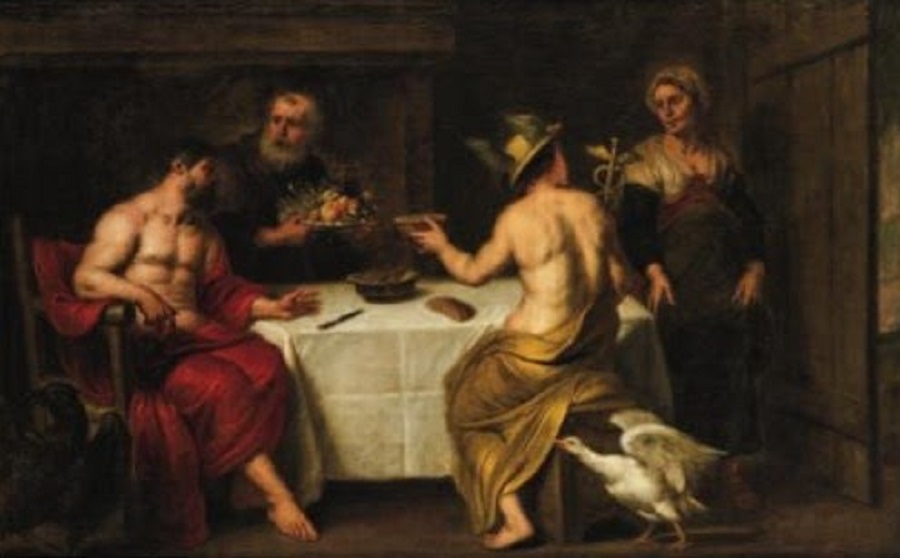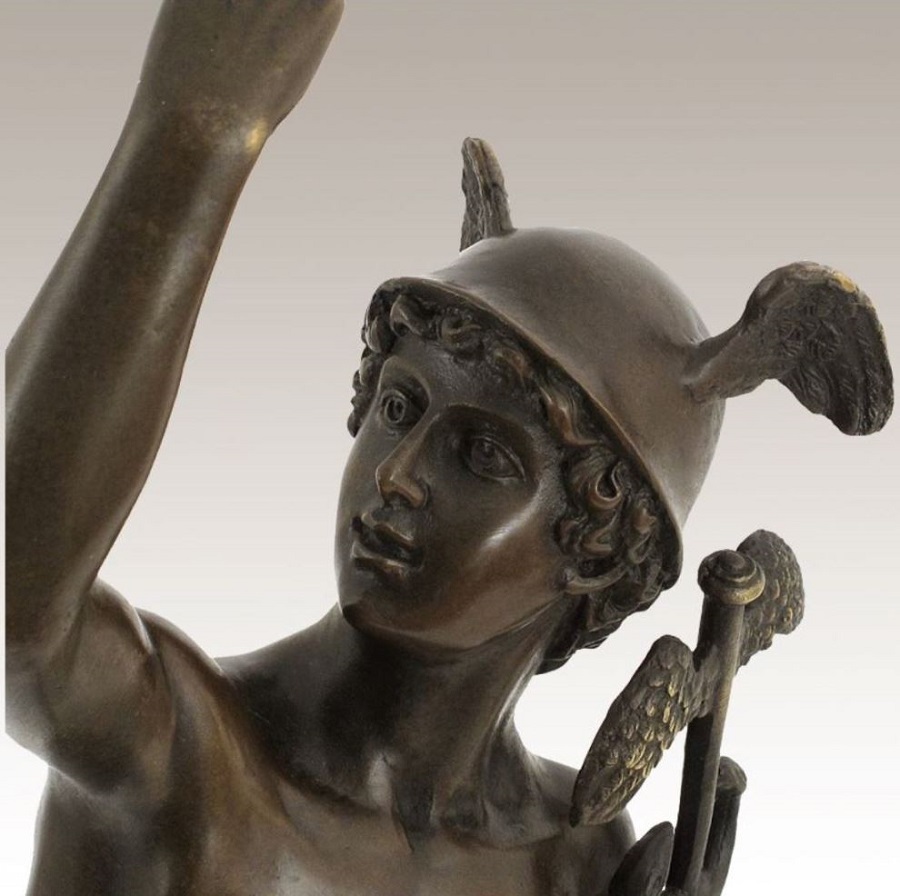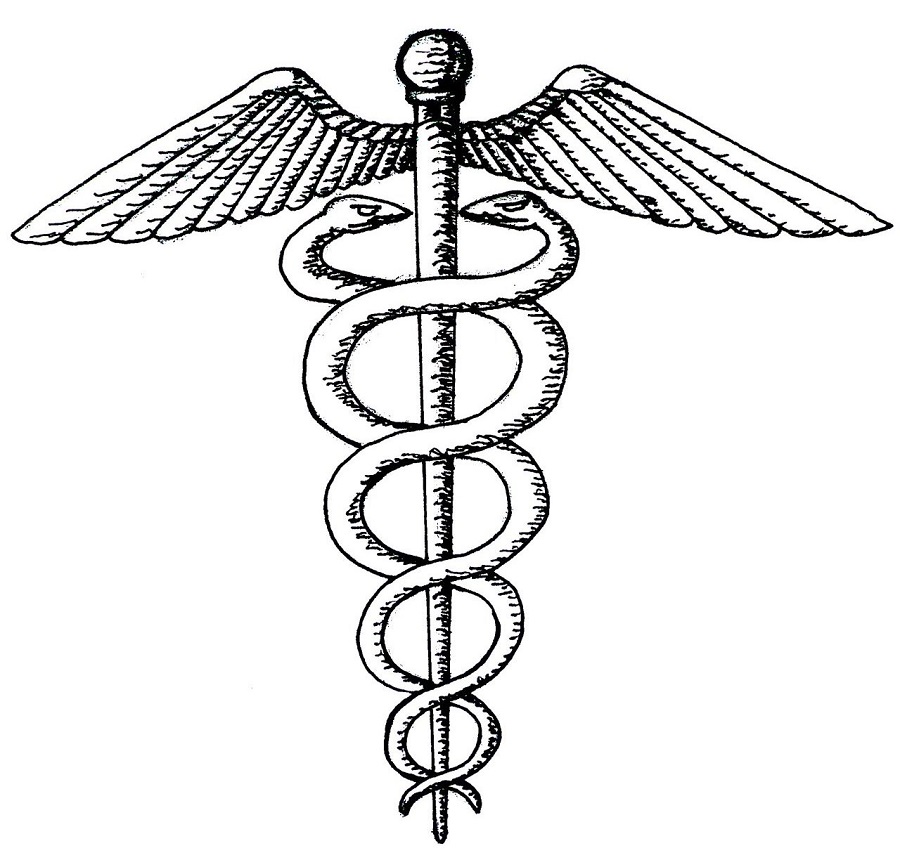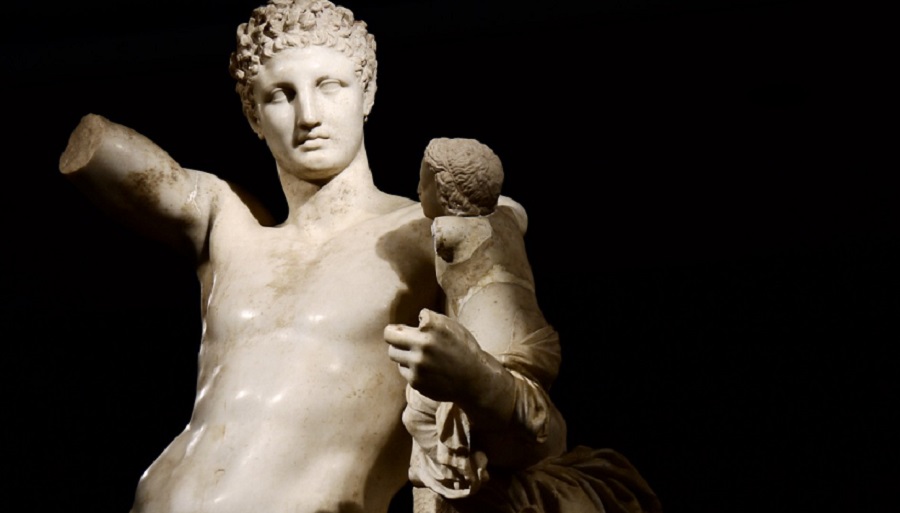In Olympus is one of the most cunning and tricky deities, he served as a messenger and in turn as a herald. Interestingly, this character enjoyed pranks, that by using only his ingenuity and cunning he managed to overcome his enemies, this is the god hermes. So we invite you to learn a little more about this cunning Greek god.
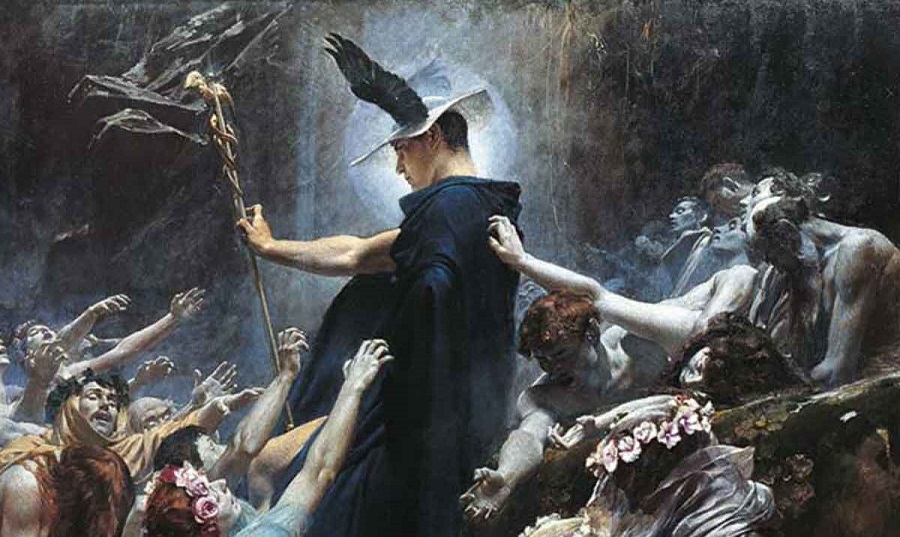
Papers of the god Hermes
The god Hermes was the swift-footed messenger, the trusted ambassador of all the gods, and the driver of the shadows in Hades. He presided over the upbringing and education of the young, and encouraged gymnastic sports and athletic activities, for which all gymnasiums and wrestling schools throughout Greece were adorned with statues of him.
It is said that he invented the alphabet and taught the art of interpreting foreign languages, and his versatility, sagacity and cunning were so extraordinary that Zeus invariably chose him as his assistant, when he traveled on earth disguised as a mortal. He worshiped Hermes as the god of eloquence, probably due to the fact that in his position as ambassador, this faculty was indispensable for the success of the negotiations entrusted to him.
He was considered as the god who gave growth and prosperity to the herds and, for this reason, the shepherds worshiped him with special veneration. In ancient times, trade was mainly done through the exchange of cattle. The god Hermes, therefore, as the god of shepherds, came to be regarded as the protector of merchants and, since ingenuity and dexterity are valuable qualities in both buying and selling, he was also considered the patron of artifice. and cunning.
In fact, this notion was so deeply ingrained in the minds of the Greek people, that it was popularly believed that he was also the god of thieves and of all people who live by their wits. As the patron of trade, the god Hermes was naturally supposed to be the promoter of trade between nations; thus, he is essentially the god of travelers over whose safety he presided and severely punished those who refused to help the lost or weary wayfarer.
He was also a guardian of streets and paths, and his statues called Herma (which were stone pillars surmounted by a head of Hermes), were placed at crossroads and often in public streets and squares. Being the god of all enterprises in which profit was a feature, he was worshiped as the giver of wealth and good luck, and any unexpected stroke of fortune was attributed to his influence. He also presided over the game of dice, in which he is said to have been instructed by Apollo.
Etymology
The name of this Greek god is derived from the term “herma”, a word of Greek origin that means “agglomerate of stones”. In Roman mythology, the god Hermes was called Mercury. He also received other titles such as the Greek god of science, roads, gymnastics, commerce, among others.
epithets
The god Hermes was given many epithets in ancient Greece denoting his multiple roles. The most important of these epithets are identified below:
- Acacesius – the god who cannot be hurt or who does not hurt.
- Agoraios – of the agora.
- Argiphon – Assassin of Argos, who remembers the final conclusion of his encounter with the many-eyed giant Argos Panoptes.
- Charidotes – charm giver.
- Cillenian- born on Mount Cylene.
- Diaktoros – the messenger.
- Dolios – the schemer.
- Diemporos – god of commerce.
- Enagonios – from the Olympic Games.
- Epimelius – caretaker of the herds.
- Eriounios – bringer of luck.
- Logios – refers to the ability of the god Hermes as a speaker, the god of eloquence. Who, in the company of Athena, was the heavenly incarnation of oratory in ancient Greece.
- Ploutodotes – giver of wealth and good luck.
- Polygius – meaning “unknown”.
- Psychopompos – transporter of souls.
cult of hermes
Hermes was honored almost everywhere in the Greek world, but especially in the Peloponnese, on Mount Cylene, and city-states such as Megalopolis, Corinth, and Argos. Athens had one of the oldest cults of the god, where the Hermeas or Hermaia festival for young children was held annually. Delos, Tanagra, and the Cyclades were other places where the god Hermes was especially popular.
Finally, the god had a notable shrine on Crete at Kato Simi, where young men on the verge of becoming full citizens participated in a two-month-long rite in which they spent time associating with older men in the nearby mountains. Another Hermaia festival in Crete allowed slaves to temporarily take on the role of their masters; once again, the association of the god Hermes with crossing borders of all kinds is evident here.
Herma
Travelers considered him their patron, and stone pillars (herma) bearing a phallus symbol were often seen placed along the paths to act as guides and offer good fortune to those who passed. The Hermas were particularly set on the borders, recalling the role of the god as a messenger between the gods and mankind, as well as his function as a guide for the dead to the next life.
In addition, Hermes was considered the patron of the house, and people often built small marble stelae in front of their doors in his honor.
Temples
According to Greek mythological stories, Lycaon the king of Arcadia was the one who laid the foundations for the first of the temples where the god Hermes was worshiped, from where he emigrated to other regions and cities such as Athens and then to all of Greece, multiplying the number of temples in total, as well as his image embedded in statues.
In particular, this happened in places considered sacred, and that preferred to practice the cult, that is, cities such as: Magna Graecia, Arcadia, Samos, Attica and Crete, among others. The indications of various offerings of votive offerings (offerings made to the ancient gods), were found in its different temples, serving as evidence and argument to reflect its role as a guide for young people and adults.
Those who visited these sanctuaries were especially warriors, hunters and soldiers before going through the ceremonial tests of initiation, to ask this god Hermes for guidance and protection. It is said that this may be why the divine is depicted in most images of him as a teenager.
Pomacos located in Tanagra was transformed into one of the temples of the god Hermes, this was under a leafy strawberry tree (fruit), where some traditions indicate that the god was created. In the hills of Fene they were adorned with three springs that were considered sacred because they believed that they had been bathed there at birth.
gifts
In ancient Greek culture, sacrifices to the god Hermes consisted primarily of offering him as gifts: incense, honey, cakes, pigs, and especially lambs and kids. As a god of eloquence, the tongues of sacrificed animals were given to him as an offering.
Festivities
In honor of the god Hermes, it was celebrated in meetings known as Hermaea, which was a special commemoration where sacrifices were made, as well as gymnastics and athletics activities. These festivities are said to date back to the XNUMXth century BC
However, there is no record of this festival until the XNUMXth century BC. These festivities are said to be the closest to initiations of all the festivals that included the performance of Greek games. The possible reasons are that perhaps it was because the participation of young children and some adults was limited according to their physical conditions.
Iconography
The representations of the god have been diverse in different periods of his life, as well as in the performance of his different functions. In ancient art he is initially portrayed as a powerful bearded man. As such, he is found on Greek vases, dressed in a traveler's cloak (chamlys) and wearing a traveler's cap (petasos) and winged leather boots (pteroeis pedila), and holding in his hands a staff (kerykeion, Latin: caduceus).
Sometimes he wears winged sandals or a hat with wings. He is later personified as a powerful, beardless young man with an intelligent and kind gaze. Famous is the statue of Praxiteles, which shows the god Hermes with the child Dionysus (XNUMXth century BC) and Hermes at rest, a bronze statue from Herculaneum, where the god rests on a rock naked with only wings on his arms. heels.
As psychopomp appears in many cenotaphs, among which is a famous relief in the Villa Albani in Rome depicting the separation of Orpheus and Eurydice, here the god Hermes wears travel clothes and his hat hanging from his neck. He is occasionally depicted as a shepherd carrying a ram, or as the god of commerce carrying a purse, for example the Hermes on Capitol Hill.
Birth, childhood and youth
Hermes was the offspring of Zeus and Maya, the first and most beautiful of the 7 Pleiades descendants of the Titan Atlas, and his birth occurred in a cave on Mount Cilene in Arcadia. As a mere infant, she exhibited an extraordinary faculty for cunning and dissimulation; in fact he was a thief from the cradle, since a few hours after his birth according to the story we find him stealthily creeping out of the cave in which he was born, to steal some oxen from his brother Apollo who was feeding the herds of Admetus.
But he had not advanced far in his expedition when he found a tortoise, which he killed, and stretching seven strings over the empty carapace he invented a lyre, on which he immediately began to play with exquisite skill. When he had had enough fun with the instrument, he placed it in his cradle and then resumed his journey to Pieria where he grazed Admetus' cattle.
Hermes steals part of Apollo's herd
Arriving at his destination at sunset, he managed to separate fifty oxen from his brother's herd, which now led before him, taking the precaution of covering their feet with sandals made of myrtle branches, to avoid detection.
But the little rogue did not go unnoticed, because the robbery had been witnessed by an old shepherd named Bato, who was taking care of the flocks of Neleo king of Pylos (father of Nestor). Hermes, afraid of being found out, bribed him with the best cow in the herd not to betray him, and Bato promised to keep the secret. But the cunning and dishonest god Hermes decided to test the integrity of the shepherd by pretending to leave assuming the form of Admetus, and then returning to the place he offered the old man two of his best oxen if he revealed the author of the theft.
The ruse succeeded, because the greedy shepherd unable to resist the tempting bait gave the desired information on which Hermes exercising his divine power transformed him into a piece of touchstone as punishment for his betrayal and greed.
Apollo discovers Hermes
The god Hermes now slaughtered two of the oxen he sacrificed for himself and the other gods, hiding the rest in a grotto. He then carefully put out the fire and after throwing his twig shoes into the river Alphaeus, he returned to Cylene. After that, Apollo by means of his all-seeing power soon finds out who it was that had stolen from him and decides to rush to Cylene, where he demanded restitution of his property.
Complaining to Maya about her son's behavior she pointed out the innocent baby who was lying apparently fast asleep in his cradle, whereupon Apollo angrily awoke the feigned sleeper and accused him of the theft; but the boy steadfastly denied all knowledge of it, and so cleverly played the part of himself that he even asked in the most naive way what manner of animals cows were.
Herme is accused before Zeus by Apollo
Apollo threatened to throw him into Tartarus if he didn't confess the truth, but all to no avail. Finally, he took the baby in his arms and brought him into the presence of his august father who sat in the council chamber of the gods. Zeus listened to the accusation made by Apollo and then sternly asked Hermes to tell where he had hidden the cattle.
The boy, still wrapped in swaddling clothes, bravely looked up into his father's face and said, “Now, am I capable of driving off a herd of cattle? I, who was born yesterday and whose feet are too big. Soft and cuddly to step on rough places? Until this moment, I slept sweetly in my mother's bosom and have never crossed the threshold of our abode. You know well that I am not guilty, but, if you wish, I will affirm it with the most solemn oaths ".
As the boy stood before him looking at the image of innocence, Zeus could not help but smile at his ingenuity and cunning, but, being perfectly aware of his guilt, he ordered him to lead Apollo to the cave where he had hidden the herd. The god Hermes, seeing that further subterfuge was useless, obeyed without hesitation. But when the divine shepherd was about to drive his cattle back to Pieria, Hermes, as if by chance, touched the strings of his lyre.
Apollo and Hermes become good friends
Until then Apollo had heard nothing but the music of his own three-stringed lyre and syrinx, or Pan's flute, and as he listened in ecstasy to the delightful chords of this new instrument his longing to possess it grew so great that he he rejoiced by offering the oxen in return and promising at the same time to give Hermes complete dominion over the flocks and herds, as well as over the horses and all the wild animals of the woods and jungles.
The offer was accepted and thus a reconciliation between the brothers took place, this is how the god Hermes was henceforth transformed into the god of shepherds, while Apollo enthusiastically devoted himself to the art of music. They then proceeded together to Olympus, where Apollo introduced Hermes as his chosen friend and companion, and having made him swear by the Styx, that he would never steal his lyre or bow, nor invade his sanctuary at Delphi, presented him with the Caduceus or golden wand.
This wand was crowned with wings and when presenting it to Hermes, Apollo informed him that it possessed the power to unite in love all beings divided by hate. Wanting to test the truth of this claim, the god Hermes threw her between two fighting snakes after which the enraged combatants embraced each other in a loving embrace and snuggled around the staff, remaining permanently attached to it.
Hermes is appointed Herald and driver of the shadows
The wand itself represented power, the snakes wisdom, and the wings office, all qualities characteristic of a trusted ambassador. The young god was now presented by his father with a winged silver cap (Petasus), and also with silver wings for his feet (Talaria), and was immediately appointed herald of the gods and conductor of the shadows of Hades, an office which until then it had been filled by the same.
As the messenger of the gods, we find him employed on all occasions requiring special skill, tact, or speed. Thus he leads Hera, Athena and Aphrodite to Paris, he leads Priam to Achilles to demand the body of Hector, he binds Prometheus to Mount Caucasus, he secures Ixion to the eternal turning wheel, he destroys Argos, the guardian of the hundred eyes of Io, among others.
As a driver of shadows, Hermes was always invoked by the dying to grant them safe and swift passage across the Styx. He also possessed the power to bring deceased spirits back to the upper world and thus was the mediator between the living and the dead.
Consorts and offspring
Despite his limited place in the surviving mythical corpus, the god Hermes was credited with having fathered numerous children, both through divine and human relationships. Some of these offspring include:
- Hermaphrodite, an immortal son of Hermes through Aphrodite who became a hermaphrodite when the gods literally granted the nymph Salmacis's wish that they would never be apart.
- Priapus, another son of the union between Hermes and Aphrodite, who was a phallic god of fertility.
- Tyche, the goddess of luck, was sometimes said to be the daughter of Hermes and Aphrodite.
- Abdero a young mortal son of the god Hermes who was swallowed by the Mares of Diomedes.
- Autolycus, the prince of thieves, was the son of Hermes and Quíone was a daughter of Daedalion; and later grandfather of Ulysses.
- Pan, the satyr god of "pasture and fertility", a son of the god Hermes by Dryope or Penelope.
Badges and attributes of the god Hermes
Among the hallmarks and attributes of the god Hermes we can primarily find his famous insignia such as the Herald rod, various plants, as well as various sacred animals binding the god and his assistant gods. Specifically these are:
- Sandals: They were beautiful and golden carried the god across land and sea with the speed of the wind; but Homer does not specify that these were provided with wings. Plastic art, on the other hand, required some external sign to express this quality of the god's sandals, and therefore he formed wings on his ankles from which they are called ptenopedilos or alipes.
- hat with wings: Hermes used a traveler's hat with a wide brim or with wings. The first was called the Cap of Aidoneus (the Invisible) because it gave the wearer the power of invisibility.
- Herald's Rod: The god always carried a golden "kerykeion" or herald's staff as identification in his role as messenger of the gods, which was also used to fall asleep. In later times, it was adorned with a pair of wings, expressing how quickly the messenger of the gods moved from place to place.
- white ribbons: these were the ones that initially surrounded the herald's staff, they were transformed by the following artists into two vipers, according to stories, although the ancients themselves explained them, either by tracing them to some feat of the god, or considering them as symbolic representations of prudence, lifetime. , health and the like.
- Hermes Blade: Hermes always wielded a golden or adamantine blade.
- shepherd's pipes: the god Hermes created the shepherd's pipes that he exchanged with Apollo, the god of music, for certain privileges. However, the god continued to play this crude instrument.
- Livestock: This god obtained a herd of divine cattle from Apollo, which he herded in the sacred pastures of Mount Olympus.
- Hare: this little animal was sacred to Hermes due to its proliferation. So this, he placed the animal among the stars as the constellation of Lepus.
- Halcón: This was a sacred bird for the god Hermes, since using his powers he transformed two individuals, Hierax and Daidalon, into this type of bird.
- SeamTurtle: Equally sacred to Hermes, since this god changed the physical state of the Quelona nymph by turning her into a tortoise and also created the first lyre with the carapace of this animal.
- The crocus flower: this type of flower that was harvested in the mountains, was consecrated to the god Hermes; There was a belief that the god made this plant grow from the blood of his beloved Crocus.
- strawberry tree: strawberry tree was considered sacred to Hermes, because it was said that the god in his childhood time had been suckled under the branches of such a tree.
- oreiades: these were the nymphs of the mountains, who were considered assistants to Hermes in the wild territories of Arcadia.
- bread and loaves: Pan was one of the sons of the god Hermes, who was also considered the god of the herds of goats; additionally, there were the Panes, who were a tribe whose physical characteristic was the legs of goats in their individuals, these together with the first were followers and assistants of the god Hermes in the mountains of Arcadia.
- satyrs: These were fertility spirits of the forest, which were commonly linked with Hermes.
- Oneiroi: they were the spirits of the dream assistants of Hermes Khthonios (of the underworld), who guided them from his subterranean kingdom to the minds of sleeping men.
in the myths
The god Hermes appears in various narratives of Greek mythology, his most prominent appearances are those mentioned below:
The Iliad
Hermes figures in the Trojan War told by Homer in the Iliad. Although in one long passage he acts as adviser and guide to the Trojan king Priam in his attempt to recover the body of his fallen son Hector, Hermes actually supports the Achaeans in the Trojan War. Homer often describes the god as "Hermes the guide, slayer of Argos" and "Hermes the kind."
The odyssey
In The Odyssey, Hermes delivers two separate messages during Odysseus' journey to get him home safely. The first message is from Hermes to Odysseus, where the god Hermes tells Odysseus that he can protect himself from Circe's ability to turn him into an animal if she chews a magical herb. Odysseus follows Hermes' advice and does not fall victim to being turned into an animal by Circe.
Hermes' second message during Odysseus' journey home is a message to Calypso. Hermes tells Calypso that Zeus has ordered him to free Odysseus from his island so that he can continue his journey home.
Argus Panoptes
Hera almost discovered her husband Zeus in flagrante delicto with the nymph Io, but Zeus had swiftly turned Io into a beautiful white heifer. However, Hera was not fooled and asked for the heifer as a gift, and of course Zeus could hardly refuse. Hera then appointed Argos Panoptes as herdsman for the heifer, preventing Zeus from visiting the nymph or transforming her back into nymph form. Thus, Io was tied to an olive tree in a sacred forest by the giant.
Hera's task for Argos Panoptes would be the one that would bring death to the all-seeing giant, as Io's suffering ultimately forced Zeus to rescue his lover. Zeus delegated his favorite immortal son, the god Hermes, to save and recover Io. Although he was a clever, cunning and thief, Hermes could not simply steal the heifer, because Argos Panoptes had the ability to see everything that was happening around him. Then, the god Hermes disguised himself as a shepherd and went to sit next to the giant in the shade.
Hermes almost immediately began to tell various tales about the gods of Olympus, while playing relaxing music on his reed flutes. The day progressed, and the soft music made one eye after another close as sleep took over the ever-awake Argos Panoptes. Finally, all of Argos's eyes closed before he was struck by Hermes, either killing the giant with a stone or cutting off his head.
Zeus's lover Io was now free, but her ordeal was not over because Hermes could not transform Io back into her nymph form, so Io wandered the earth as a heifer until she finally found sanctuary in Egypt. . After the death of one of her favorite servants, Hera took the eyes of the late Argos Panoptes and placed them on the feathers of her sacred bird, the peacock.
perseus
When Polydectes ordered Perseus to retrieve Medusa's head, Hermes gave Perseus his pair of winged sandals. These winged sandals helped Perseus escape Medusa's cave once he beheaded her. This kept Perseus alive, as he prevented Medusa's sisters from reaching Perseus and killing him.
Prometheus
In the myth of Prometheus, the god Hermes is manifested, when Zeus delegates to him the task of persuading Prometheus to firmly transmit the prophecy about the end of Zeus' mandate. He knows that this is the only one who can explain it to him, but he refuses and shows Hermes that he chooses to be unhappy than to be a servant of Zeus like him.
Hermes tells him that if he refuses to tell the prophecy, Zeus will incite a storm that will cause the top of the mountain he is under to collapse on top of him and then a vulture will come every day to eat his liver, to which Prometheus he tells her that he has no intention of giving in and that he already knew everything he told her.
Herse, Aglaurus and Pandrosus
It is said that Hermes was one day flying over Athens, when, looking towards the city, he saw several maidens returning in solemn procession from the temple of Pallas-Athena. The most important of them was Herse, the beautiful daughter of King Cecrops, and the god Hermes was so impressed by her excessive beauty that he decided to seek a presentation of her with her. Accordingly, he appeared at the royal palace and begged her sister Agraulo to favor her dress; but, being miserly in spirit, he refused to do so without payment of a huge sum of money.
It did not take long for the messenger of the gods to obtain the means to fulfill this condition, and he soon returned with a well-filled bag. But meanwhile Athena, to punish Agraulo's greed, had caused the demon of envy to seize her, and the consequence was that she could not contemplate her sister's happiness, so she sat before the door and resolutely refused. to allow Hermes to enter.
Who tried all the persuasions and flattery within his reach with her, but she was still stubborn. At last, her patience exhausted, transforming her into a mass of black stone and removing the obstacle to her desire, she succeeded in persuading Herse to become her wife.
Other stories
Poets tell many amusing stories of the youthful tricks this mischief-loving god played on the other immortals. Between them:
- He had the audacity to remove Medusa's head from Athena's shield, which he playfully placed on Hephaestus's back.
- He also stole Aphrodite's belt.
- He deprived Artemis of her arrows and Ares of his spear.
These acts were always performed with such elegant skill, combined with such perfect good humor, that even the gods and goddesses he thus provoked were willing to forgive him, and he became a universal favorite with them all.
Other equally interesting stories where the god Hermes was present, in relation to mortals or demigods, are reported that:
- He once took on the guise of a slave trader and sold the hero Heracles, or Hercules, to the queen of Lydia.
- He also helped Heracles catch the three-headed dog Cerberus from the Underworld.
- She often had the job of rescuing and caring for babies such as Dionysus, Arcas, and Helen of Troy.
- He disguised himself as a traveler to test the shelter of mortals.
- One of his jobs was to search for Persephone of the god Hades in the underworld.
hermes in art
In the classical and archaic art of ancient Greece, Hermes is represented as a beardless young man, with a broad chest and elegant but muscular limbs; his face is handsome and intelligent, and an affable smile of good-natured benevolence plays on his finely chiseled lips.
As a messenger of the gods, he carries the Petasus and Talaria, and carries in his hand the Caduceus or herald's staff. As the god of eloquence, he is often depicted with gold chains dangling from his lips, while as the patron of merchants, he carries a briefcase in his hand; additionally in the statues of him he was also sometimes accompanied with a lyre.
He may also carry a ram in a nod to his role as patron of shepherds, especially in Boeotian and Arcadian art. In his association with youths, the god was often depicted holding the infant Hercules or Achilles. At the same time, his association with commerce is evidenced in the Delos seals where he carries a bag.
Perhaps the most famous depiction of Hermes in Greek art is the magnificent statue of Praxiteles (c. 330 BC) which once stood in the temple of Hera at Olympia and now resides in the site's archaeological museum. This marble statue of the god Hermes and the child Dionysus shows a handsome young man looking with kindness and affection at the child resting on his arm, but unfortunately nothing remains of the child except the right hand that is lovingly placed on it. arm of his protector.
Hermes in contemporary culture
While Hermes was not the most popular of the gods due to his unimposing reputation, he and his famous accoutrements have often featured in popular culture. The god Hermes has appeared in most modern depictions of Greek mythology, such as:
- In Disney's Hercules (1997), Hermes was depicted as a bespectacled Greek messenger who avoids confrontation.
- His character was voiced by David Letterman's gang leader Paul Schaffer.
- In the film version of Rick Riordan's novel Percy Jackson and the Sea of Monsters, Nathan Fillion played the god Hermes. In the movie, he was introduced to her again as a courier (to be more specific, as an executive of a package delivery company), who was quirky and unpredictable, though ultimately well-intentioned.
The various instruments of the god Hermes were often used to refer to his attributes and abilities. His winged temple feathers have become synonymous with speed and reliability; They have often been featured in various advertisements and logos, such as:
- Goodyear used this symbol to sell its tires evoking hopes of speed and reliability.
- The god Hermes has also been used as a logo for many national mail services.
Perhaps most famous of all, the staff of Hermes, the kerikeion or caduceus, a winged staff with a pair of serpents coiled around it, was used as a general symbol of medicine and served as the primary symbol of the American Medical Association. Such a symbol was but another expression of Hermes, who delivered him from sickness to health.
Mercury and Hermes
Mercury was the Roman god of trade and profit. We find mention of a temple being erected to him near the Circus Maximus as early as AC 495; and he also had a temple and a sacred spring near Porta Capena. Magical powers were attributed to the latter, and on the festival of Mercury, which was celebrated on May 25, it was customary for merchants to sprinkle themselves and their merchandise with this holy water, in order to secure great profits from their merchandise.
The Festivals (Roman priests whose duty it was to act as guardians of the public faith) refused to recognize Mercury's identity with Hermes, and ordered that he be depicted with a sacred branch as an emblem of peace, instead of the Caduceus. In later times, however, he became fully identified with the Greek god Hermes.
If you found this article about the God Hermes interesting, we invite you to enjoy these others:
